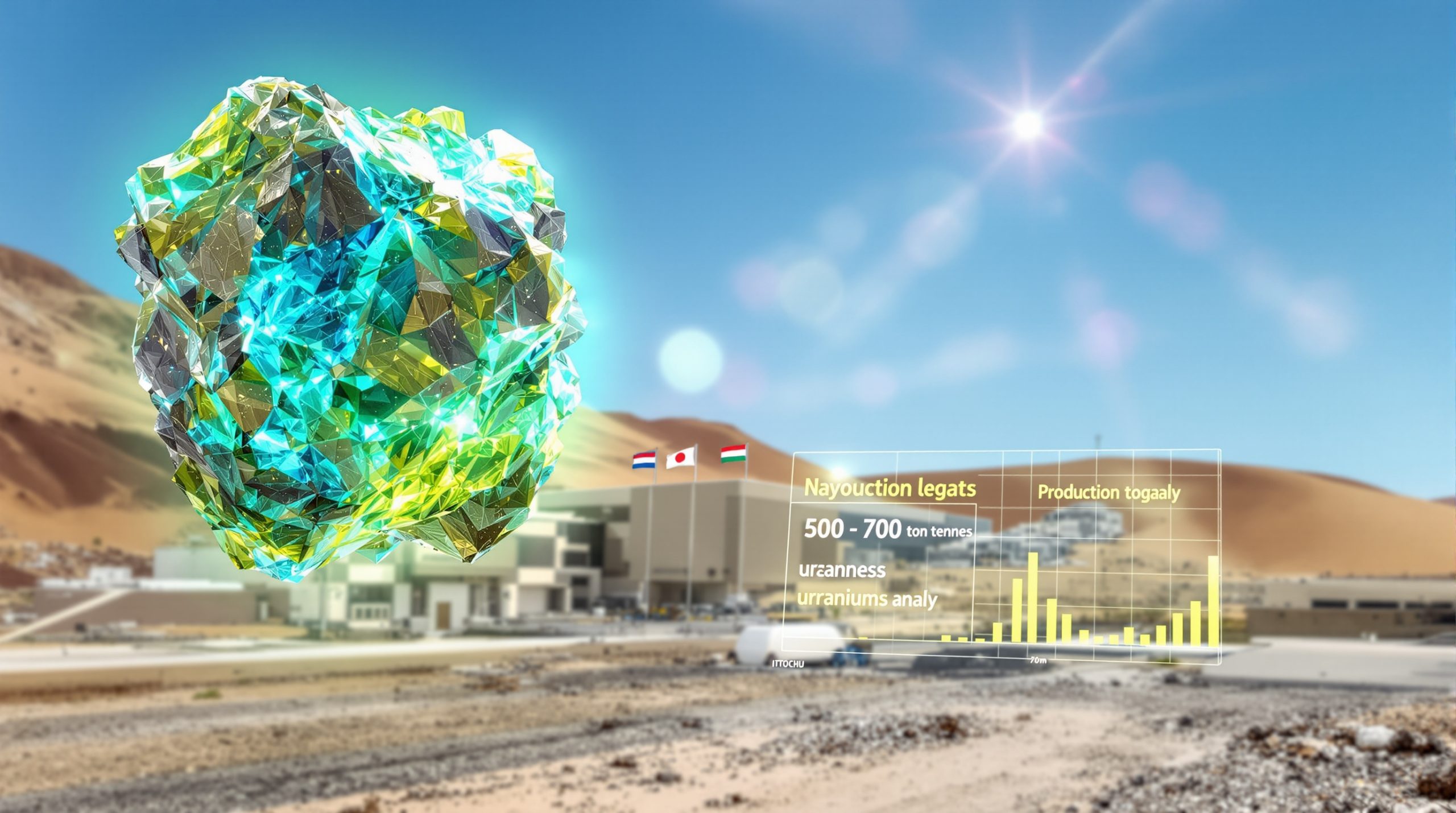China-Malaysia Rare Earths Refinery Project: Strategic Partnership or Geopolitical Gambit?
Key Project Details and Strategic Significance
The emerging collaboration between China and Malaysia represents a potential watershed moment in the global rare earths industry. Early discussions have begun between Malaysia's Khazanah Nasional sovereign wealth fund and an unnamed Chinese state-owned enterprise to establish a joint venture rare earths processing facility in Malaysia.
This proposed facility aims to handle both light and heavy rare earth elements, addressing a critical gap in global processing capacity outside China. What makes this partnership particularly noteworthy is that it represents a significant policy departure for China, which has historically banned the export of its processing technology to protect its industry dominance.
Malaysian government estimates indicate the country possesses approximately 16.1 million metric tons of rare earth deposits, providing substantial raw material potential for the project. The preliminary discussions focus on a technology-for-resources exchange, with China offering its processing expertise in return for access to Malaysia's untapped reserves.
Khazanah's chief investment officer, Hisham Hamdan, has acknowledged that rare earths are among the industries being explored by the fund, though he declined to confirm specific talks about the proposed refinery, noting it was "way too early" in the process.
Current Status of Negotiations
Discussions remain in preliminary stages with no formal agreements signed as of recent reports. Malaysian Natural Resources Minister Johari Abdul Ghani confirmed in August that China has expressed willingness to provide technical and technological assistance in processing rare earths.
According to Malaysian officials, Chinese President Xi Jinping has specifically requested that cooperation be restricted to state-linked companies to protect proprietary technology and trade secrets. This stipulation underscores the strategic value China places on its rare earths processing knowledge.
Both sides acknowledge significant hurdles remain before any deal can be finalized. Among the key concerns is whether Malaysia can supply sufficient raw material for the plant. Additionally, environmental impact considerations and complex regulatory requirements present substantial challenges to moving forward.
Why Are Rare Earths Strategically Important?
Critical Applications Driving Global Demand
Rare earth elements serve as essential components in a wide range of modern technologies. These minerals play crucial roles in manufacturing electric vehicles, where they're used in motors and battery systems. Renewable energy infrastructure, particularly wind turbines, relies heavily on rare earth-based permanent magnets.
Consumer electronics represent another major application, with rare earths incorporated into smartphones, computers, and other devices that power our digital economy. The defense sector has particular interest in these materials, as they're essential for advanced weapons systems, communications equipment, and various military technologies.
Heavy rare earth elements face particularly acute supply challenges compared to their light rare earth counterparts. These heavier elements are less commonly found in economically viable concentrations, creating supply bottlenecks even as demand continues to increase with the clean energy transition and defence-critical materials strategy.
Global manufacturers experienced the vulnerability of rare earths supply chains firsthand following Beijing's export restrictions in 2023. These measures led to production delays for major automakers and magnet producers, highlighting the strategic importance of diversifying supply sources.
Global Supply Chain Vulnerabilities
China's dominance in the rare earths processing sector presents significant strategic vulnerabilities for global supply chains. Currently, China controls approximately 85% of global rare earths processing capacity, giving it considerable leverage over industries dependent on these materials.
This concentration of processing capability has made manufacturers worldwide vulnerable to supply disruptions. Recent Chinese export restrictions have demonstrated how quickly production bottlenecks can develop when access to refined rare earths is constrained.
Western nations have actively sought supply chain diversification strategies to reduce dependence on Chinese sources. However, developing processing capacity outside China requires significant investment, technological expertise, and time – resources that aren't readily available in most countries.
Despite these diversification efforts, processing capacity outside China remains limited. Australia's Lynas Rare Earths, which operates Malaysia's only current processing facility, represents the world's largest non-Chinese producer but still accounts for only a fraction of global output. The ongoing US-China trade war impact has further highlighted the importance of secure supply chains for these critical materials.
How Would This Partnership Transform the Rare Earths Landscape?
Potential Market Impacts
If successful, this joint venture would position Malaysia as one of few countries with both Chinese and non-Chinese rare earths processing technologies. Minister Johari Abdul Ghani has highlighted this unique advantage, noting it would give Malaysia significant strategic positioning in global supply chains.
The project would directly compete with Australia's Lynas Rare Earths, which currently operates Malaysia's only existing processing facility in Pahang state. According to Malaysian sources familiar with the discussions, Beijing views the partnership as a way to limit competition from this Australian rival.
From a market perspective, the development could potentially reduce China's near-monopoly on heavy rare earths processing. This diversification would address a critical supply chain vulnerability for manufacturers globally, potentially stabilizing prices and ensuring more consistent availability of these strategic minerals.
The establishment of new regional supply chains less vulnerable to geopolitical tensions could benefit downstream manufacturers. Companies producing everything from consumer electronics to clean energy technologies might gain access to more reliable sources of refined rare earth materials.
Technology Transfer Considerations
China's willingness to share processing technology represents a remarkable shift in policy. Historically, Beijing has strictly prohibited the export of its rare earths processing technology to protect its dominant market position.
Knowledge transfer could enable Malaysia to develop indigenous rare earths expertise. This capability building would complement Malaysia's existing raw material reserves, creating a more comprehensive domestic value chain for these critical minerals energy security.
The processing capabilities would align with Malaysia's efforts to move up the value chain in resource industries. Rather than simply exporting raw materials, the country aims to capture more economic value through processing and refining activities.
If successful, this collaboration could establish a model for future Chinese technology partnerships in strategic sectors. Other resource-rich countries might seek similar arrangements, potentially reshaping how critical mineral resources are developed globally.
What Challenges Threaten the Project's Viability?
Supply Chain Concerns
Chinese officials have expressed concerns about whether Malaysia can provide sufficient raw materials to support the processing facility. This represents a fundamental challenge to the project's economic viability.
Malaysia has implemented a ban on raw rare earths exports to prevent resource loss, which complicates potential supply arrangements. The only exception granted was in 2022 for a pilot mining project aimed at establishing national operating guidelines.
It remains unclear how the project would secure consistent feedstock for processing operations. Without reliable access to raw materials, the economics of the processing facility come into question.
Potential dependence on imported concentrates could undermine the project's economic viability. Transportation costs and supply uncertainties would add complexity to operations and potentially impact profitability.
Environmental and Regulatory Hurdles
Malaysia maintains strict environmental protections for sensitive areas, particularly regarding mining activities. The country has explicitly stated it does not support rare earths mining in permanent forest reserves and water catchment areas.
Previous rare earths processing operations in Malaysia have faced significant public opposition due to environmental concerns. These historical challenges could resurface if the new project doesn't adequately address potential environmental impacts.
Mining and processing activities typically require approvals from both state and federal authorities in Malaysia, creating a complex regulatory landscape. Navigating these requirements can be time-consuming and uncertain.
The environmental approval process presents a particular challenge given the sensitive nature of rare earths processing. Effective waste management and pollution control systems will be essential for gaining regulatory approvals and public acceptance.
Key Regulatory Restrictions in Malaysia
| Protected Area Type | Mining Permitted? | Conditions |
|---|---|---|
| Permanent Forest Reserves | No | Strictly prohibited |
| Water Catchment Areas | No | Strictly prohibited |
| Agricultural Land | Limited | Subject to extensive environmental assessment |
| State Land | Conditional | Requires both state and federal approvals |
How Does This Fit Into Regional Rare Earths Development?
Malaysia's Existing Rare Earths Industry
Australia's Lynas Rare Earths currently operates a major processing facility in Malaysia's central Pahang state. As the world's largest rare earths producer outside China, Lynas represents Malaysia's existing foothold in the rare earths processing sector.
Malaysian authorities granted an exception to the rare earths export ban in 2022 for a pilot mining project. This initiative aimed to establish national operating guidelines for the sector, demonstrating Malaysia's strategic approach to developing its rare earths industry.
In a significant development, Lynas signed an agreement with Malaysia's eastern state of Kelantan in May for future supply of mixed rare earths carbonate. This arrangement represents an effort to develop local industry capabilities and secure domestic supply chains.
The Malaysian government has actively sought to develop a comprehensive domestic rare earths value chain. This strategic focus aligns with broader economic diversification goals and aims to capture more value from the country's natural resources.
Comparison with Other Regional Initiatives
Australia has made substantial investments in rare earths mining and processing capacity in recent years. The country's government has identified rare earths as a strategic priority and provided funding and policy support to develop the sector.
Japan has pursued partnerships with various countries to secure non-Chinese supply chains for rare earths. These efforts reflect Japan's manufacturing sector's vulnerability to supply disruptions and its strategic interest in diversification.
Vietnam has explored development of its significant rare earth deposits, though progress has been slower than anticipated. The country faces technical and environmental challenges similar to those confronting Malaysia.
India has expanded mining operations to capitalize on its substantial reserves. While India possesses significant rare earth resources, it has faced challenges in developing processing capacity and competing with China's established industry.
What Are the Geopolitical Implications?
Strategic Positioning in Global Supply Chains
This project represents a potential shift in China's resource nationalism approach. Historically, China has closely guarded its rare earths processing technology to maintain market dominance, making this willingness to share expertise a notable policy change.
Malaysia could leverage its position between competing global powers to attract investment and technology transfer. By working with both Chinese and Western partners, Malaysia could establish itself as an important node in global rare earths supply chains.
Success might encourage similar partnerships in other critical mineral sectors. The model of technology-for-resources exchange could be applied to other strategically important materials where China holds technological advantages.
Diversified processing capacity could reduce market volatility during geopolitical tensions. Having multiple sources of refined rare earths would make the global market more resilient to disruptions caused by trade disputes or political conflicts.
Impact on Western Supply Chain Diversification Efforts
The China-Malaysia partnership could potentially complicate Western attempts to create China-free supply chains. Materials processed in Malaysia using Chinese technology would occupy an ambiguous position in supply chains designed to reduce dependence on China.
Malaysian processing with Chinese technology creates classification challenges for companies with strict sourcing policies. Some manufacturers might question whether such materials truly represent supply chain diversification.
Malaysia has potential to become a strategic "middle ground" in the growing supply chain competition between China and Western nations. This positioning could allow Malaysia to benefit from investment and technology flows from both directions.
The project's development may influence investment decisions for downstream manufacturing facilities. Companies producing rare earth-dependent products might consider locating facilities in Malaysia to access these processing capabilities.
How Would This Affect Global Rare Earths Markets?
Potential Price and Supply Impacts
Additional processing capacity, particularly for heavy rare earths, could help stabilize global prices by addressing critical supply bottlenecks. Increased availability of refined materials would reduce the pricing power currently held by dominant suppliers.
Diversified supply sources typically reduce market volatility by preventing any single producer from exercising excessive market control. This would benefit manufacturers by making prices more predictable and supply more reliable.
Heavy rare earths processing would address particularly critical supply challenges. These elements face more severe supply constraints than light rare earths, making additional processing capacity especially valuable.
Success could encourage additional investment in rare earths exploration globally. As processing capacity expands, companies would have greater incentive to develop new mining projects, potentially increasing overall supply.
Investment Implications
Project success would validate Malaysia's mineral development strategy and potentially attract additional foreign investment in the Malaysian mining sector. Other companies might follow China's lead in exploring partnerships with Malaysian entities.
The development could influence valuation of existing rare earths producers like Lynas. Increased competition might pressure margins, though growing overall demand could offset these effects.
New downstream manufacturing opportunities would likely emerge in proximity to the processing facility. Companies producing rare earth-dependent components might locate operations near the refinery to secure supply access.
Investors focused on critical minerals might recalibrate their assessment of supply risks in light of this new processing capacity. The project's progress will be closely monitored as an indicator of how rare earth supply chains might evolve.
What's Next for the China-Malaysia Rare Earths Project?
Key Milestones to Monitor
Industry observers should watch for a formal partnership announcement naming the specific Chinese partner. This would signal serious progression beyond preliminary discussions and outline the structure of the collaboration.
Regulatory approvals for facility location and environmental permits represent critical hurdles. The project's timeline will depend heavily on navigating Malaysia's regulatory requirements successfully.
Raw material supply agreements with domestic or international sources will be essential for operational viability. Securing consistent feedstock remains one of the project's fundamental challenges.
Construction timeline and production capacity details will provide insight into the project's scale and potential market impact. These specifications will determine how significant the facility might be in global supply chains.
Potential Timeline for Development
Continued negotiations are expected throughout the coming months as parties work to resolve key technical and commercial issues. These discussions will need to address supply concerns, technology transfer parameters, and investment structures.
Feasibility studies and environmental impact assessments would follow any formal agreement. These technical evaluations typically require 12-18 months to complete thoroughly.
Construction timeline will depend on regulatory approvals and financing arrangements. Similar facilities have required 2-3 years from groundbreaking to operational status.
Production is unlikely to begin before 2025-2026 even under an accelerated development scenario. The complex nature of rare earths processing facilities necessitates careful planning and construction, though modern mining technology could potentially accelerate some aspects of development.
FAQ: China-Malaysia Rare Earths Collaboration
What makes this partnership unique in the rare earths sector?
This would represent the first major instance of China sharing its rare earths processing technology with another country. This breaks from China's long-standing policy of protecting this strategic knowledge to maintain market dominance. The willingness to transfer technology signals a potential shift in China's approach to rare earths as a strategic resource.
How does this project relate to Malaysia's existing rare earths industry?
Malaysia already hosts a significant rare earths processing facility operated by Australia's Lynas, but this new project would introduce Chinese processing technology and potentially handle a wider range of rare earth elements. The addition of heavy rare earths processing capability would be particularly significant, as these elements face more severe supply constraints globally.
What environmental safeguards would be implemented?
While specific details haven't been announced, any project would need to comply with Malaysia's environmental regulations, which prohibit mining in sensitive areas such as permanent forest reserves and water catchment areas. Comprehensive impact assessments would be required, and the facility would need to implement advanced waste management systems to address concerns about radioactive byproducts that can be associated with rare earths processing.
How might this affect global rare earths prices?
Additional processing capacity, particularly for heavy rare earths, could help stabilize global prices by reducing supply bottlenecks and market concentration. This would potentially benefit downstream manufacturers who have faced volatile pricing and supply uncertainty. The impact would depend on the facility's production capacity and how quickly it could reach full operation.
What are the main obstacles to project implementation?
Key challenges include securing sufficient raw material supply, obtaining regulatory approvals, addressing environmental concerns, and finalizing technology transfer arrangements. The ban on raw rare earths exports from Malaysia complicates feedstock sourcing, while environmental regulations present significant hurdles given the sensitive nature of rare earths processing. Additionally, the complexity of technology transfer agreements between Chinese and Malaysian entities requires careful negotiation.
As mining industry innovation continues to advance, the success of this project could establish new paradigms for how countries approach development of critical mineral resources in an increasingly competitive global landscape.
Want to Be First to Discover Major ASX Mineral Finds?
Don't miss out on the next market-moving mineral discovery on the ASX. Visit the Discovery Alert discoveries page to see how their proprietary Discovery IQ model delivers instant notifications on significant mineral discoveries, giving subscribers a crucial market advantage before news spreads.




